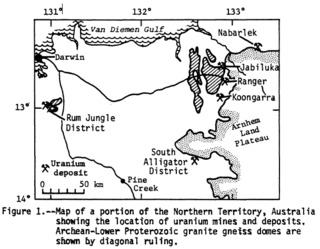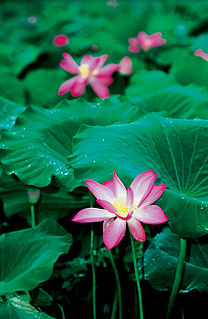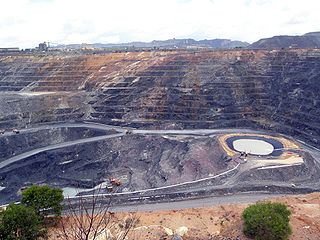
Jabiluka is a pair of uranium deposits and mine development in the Northern Territory of Australia that was to have been built on land belonging to the Mirarr Aboriginal people. The mine site is surrounded by, but not part of, the World Heritage–listed Kakadu National Park.

The Ranger Uranium Mine is a uranium mine in the Northern Territory of Australia. It is surrounded by, but separate from Kakadu National Park, 230 km east of Darwin. The orebody was discovered in late 1969, and the mine commenced operation in 1980, reaching full production of uranium oxide in 1981. It is operated by Energy Resources of Australia, a 68% subsidiary of Rio Tinto Group. Uranium mined at Ranger is sold for use in nuclear power stations in Asia, Europe and North America.

The Australian Conservation Foundation (ACF) is Australia's national environmental organisation. ACF is a community of over 400,000 people who speak out, show up and act for a world where forests, rivers, people and wildlife thrive. Founded in 1965, ACF has been a powerful voice for the environment for more than 50 years. It is an independent, non-partisan, non-profit organisation focused on advocacy, policy, research and community organising.

Alligator Rivers is the name of an area in an Arnhem Land region of the Northern Territory of Australia, containing three rivers, the East, West, and South Alligator Rivers. It is regarded as one of the richest biological regions in Australia, with part of the region in the Kakadu National Park. It is an Important Bird Area (IBA), lying to the east of the Adelaide and Mary River Floodplains IBA. It also contains mineral deposits, especially uranium, and the Ranger Uranium Mine is located there. The area is also rich in Australian Aboriginal art, with 1500 sites. The Kakadu National Park is one of the few World Heritage sites on the list because of both its natural and human heritage values. They were explored by Lieutenant Phillip Parker King in 1820, who named them in the mistaken belief that the crocodiles in the estuaries were alligators.

Jabiru is a town in the Northern Territory of Australia. It was originally built in 1982 as a closed town to house the community living at Jabiru East near the Ranger Uranium Mine eight kilometres away. Both the mine and the town are completely surrounded by Kakadu National Park. At the 2006 census, Jabiru had a population of 1,135.
Big Bill Neidjie was the last surviving speaker of the Gaagudju language, an indigenous language from northern Kakadu after which the World Heritage-listed Kakadu National Park is named. He was a senior elder of Kakadu National Park and a traditional owner of the Bunitj estate in northern Kakadu, perhaps the most spectacular National Park in Australia. His decision to open up this land to other people was instrumental in the creation of Kakadu National Park. He was usually called Big Bill Neidjie because of his physique and physical strength, probably gained through his time working on the luggers, and was also called Kakadu Man, after the title of his first book.

Energy Resources of Australia Ltd is a public company based in Australia. It is a subsidiary of the Rio Tinto Group which owns 68.4% of the company. The remainder is publicly held and traded on the Australian Securities Exchange. The chairman is Peter McMahon and Chief Executive is Andrea Sutton.

Kakadu National Park, located in the Northern Territory of Australia, possesses within its boundaries a number of large uranium deposits. The uranium is legally owned by the Australian Government, and is sold internationally, having a large effect on the Australian economy. The mining has been controversial, due to the widespread publicity regarding the potential danger of nuclear power and uranium mining, as well as because of objections by some indigenous groups. This controversy is significant because it involves a number of important political issues in Australia: Native Title, the environment, and Federal-State-Territory relations.

Ubirr is a rock formation within the East Alligator region of Kakadu National Park in the Northern Territory of Australia, and is known for its rock art. It consists of a group of rock outcrops on the edge of the Nadab floodplain where there are several natural shelters that have a collection of Aboriginal rock paintings, some of which are many thousands of years old. The art depicts certain creation ancestors as well as animals from the area such as barramundi, catfish, mullet, goannas, long-necked turtles, pig-nosed turtles, rock ringtail possums, and wallabies.

This is a list of plants commonly found in Kakadu National Park, Northern Territory of Australia. Where known, common names are given in English and in Gun-djeihmi, a commonly spoken indigenous language in the area, are given in parentheses.
Andrew A. Snelling is a young-Earth creationist geologist who works for Answers in Genesis.
Yvonne Margarula is an Australian environmentalist who won the 1998 Friends of the Earth International Environment Award and the 1998 Nuclear-Free Future Award. She also won the 1999 U.S. Goldman Environmental Prize, with Jacqui Katona, in recognition of efforts to protect their country and culture against uranium mining.
Jacqui Katona is a western-educated Aboriginal woman who led the campaign to stop the Jabiluka uranium mine in the Northern Territory. In 1998 the Mirrar Aboriginal people, together with environmental groups, used peaceful on-site civil disobedience to create one of the largest blockades in Australia's history. Katona won the 1999 U.S. Goldman Environmental Prize, with Yvonne Margarula, in recognition of efforts to protect their country and culture against uranium mining.
The Australian Uranium Association was an Australian industry trade group which represented companies involved in uranium exploration, mining and export. It operated from September 2006 until 2013, after which its responsibilities were absorbed by the Minerals Council of Australia.
The Supervising Scientist is a statutory office under Australian law, originally created to assist in the monitoring of what was then one of the world's largest uranium mines, the Ranger Uranium Mine. It now provides advice more generally on a 'wide range of scientific matters and mining-related environmental issues of national importance, including; radiological matters and tropical wetlands conservation and management'. The Supervising Scientist is administered as a division within the Department of the Environment, Water, Heritage and the Arts.

Radioactive ores were first extracted in South Australia at Radium Hill in 1906 and Mount Painter in 1911. 2,000 tons of ore were treated to recover radium for medical use. Several hundred kilograms of uranium were also produced for use in ceramic glazes. In 2017, of the world's estimated uranium resources, 30% were in Australia, ahead of the second largest, Kazakhstan. In terms of production, Canada is the largest supplier, followed by Kazakhstan and Australia. Uranium mined in Australia is entirely for export. Australia exported 64,488 tonnes of uranium in the ten years to 2017.

Jabiru Airport is an airport located 1.5 nautical miles northwest of Ranger Uranium Mine and east of Jabiru in the Northern Territory of Australia. Situated within the Kakadu National Park it consists of one runway and five parking spaces for light aircraft such as Cessna 152s. Charter flight operators include AAA Charter, Kakadu Air and North Australian Helicopters.
The Gaagudju, also known as the Kakadu, are an indigenous Australian people of the Northern Territory.










